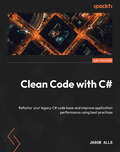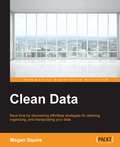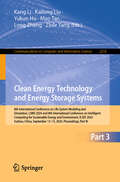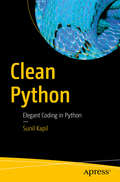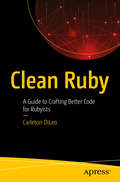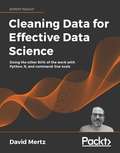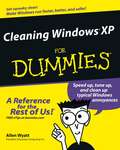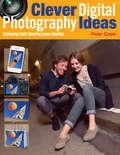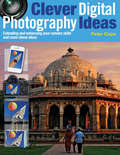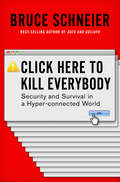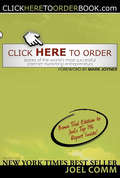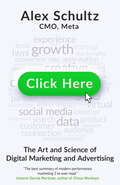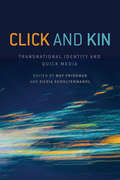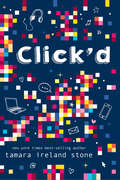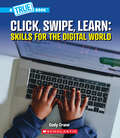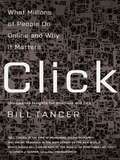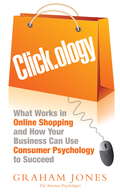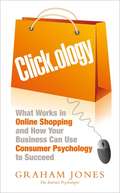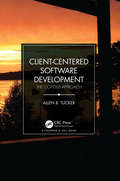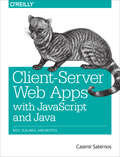- Table View
- List View
Clean Code with C#: Refactor your legacy C# code base and improve application performance using best practices
by Jason AllsEnhance your programming skills through code reviews, TDD and BDD implementation, and API design to overcome code inefficiency, redundancy, and other issues arising from bad codeKey FeaturesWrite code that seamlessly integrates with other systems while maintaining well-defined software boundariesUnderstand how coding principles and standards elevate software qualityLearn how to avoid common errors while implementing concurrency or threadingPurchase of the print or Kindle book includes a free PDF eBookBook DescriptionTraditionally associated with Windows desktop applications and game development, C# has expanded into web, cloud, and mobile development. However, despite its extensive coding features, professionals often encounter issues with efficiency, scalability, and maintainability due to poor code. Clean Code in C# guides you in identifying and resolving these problems using coding best practices. This book starts by comparing good and bad code to emphasize the importance of coding standards, principles, and methodologies. It then covers code reviews, unit testing, and test-driven development, and addresses cross-cutting concerns. As you advance through the chapters, you’ll discover programming best practices for objects, data structures, exception handling, and other aspects of writing C# computer programs. You’ll also explore API design and code quality enhancement tools, while studying examples of poor coding practices to understand what to avoid. By the end of this clean code book, you’ll have the developed the skills needed to apply industry-approved coding practices to write clean, readable, extendable, and maintainable C# code.What you will learnMaster the art of writing evolvable and adaptable codeImplement the fail-pass-refactor methodology using a sample C# console applicationDevelop custom C# exceptions that provide meaningful informationIdentify low-quality C# code in need of refactoringImprove code performance using profiling and refactoring toolsCreate efficient and bug-free code using functional programming techniquesWrite cross-platform code using MAUIDevelop cloud-deployable microservices for versatile applicationsWho this book is forThis coding book is for proficient C# developers, team leads, senior software engineers, and software architects who want to improve the efficiency of their legacy systems. A strong understanding of C# programming is assumed.
Clean Data
by Megan SquireIf you are a data scientist of any level, beginners included, and interested in cleaning up your data, this is the book for you! Experience with Python or PHP is assumed, but no previous knowledge of data cleaning is needed.
Clean Energy Technology and Energy Storage Systems: 8th International Conference on Life System Modeling and Simulation, LSMS 2024 and 8th International Conference on Intelligent Computing for Sustainable Energy and Environment, ICSEE 2024, Suzhou, China, September 13–15, 2024, Proceedings, Part III (Communications in Computer and Information Science #2218)
by Kang Li Zhile Yang Kailong Liu Long Zhang Yukun Hu Mao TanThe five-volume set constitutes the thoroughly refereed proceedings of the 8th International Conference on Life System Modeling and Simulation, LSMS 2024, and of the 8th International Conference on Intelligent Computing for Sustainable Energy and Environment, ICSEE 2024, which were held during September 13-15, in Suzhou, China. The 29 papers presented were carefully reviewed and selected from over 496 submissions. The LSMS and ICSEE international conference series aim to bring together international researchers and practitioners in the fields of advanced methods for life system modeling and simulation, as well as advanced intelligent computing theory, methodologies, and engineering applications in achieving net zero across all sectors to tackle the global climate change challenge.
Clean Python: Elegant Coding in Python
by Sunil KapilDiscover the right way to code in Python. This book provides the tips and techniques you need to produce cleaner, error-free, and eloquent Python projects. Your journey to better code starts with understanding the importance of formatting and documenting your code for maximum readability, utilizing built-in data structures and Python dictionary for improved maintainability, and working with modules and meta-classes to effectively organize your code. You will then dive deep into the new features of the Python language and learn how to effectively utilize them. Next, you will decode key concepts such as asynchronous programming, Python data types, type hinting, and path handling. Learn tips to debug and conduct unit and integration tests in your Python code to ensure your code is ready for production. The final leg of your learning journey equips you with essential tools for version management, managing live code, and intelligent code completion. After reading and using this book, you will be proficient in writing clean Python code and successfully apply these principles to your own Python projects. What You’ll Learn Use the right expressions and statements in your Python code Create and assess Python Dictionary Work with advanced data structures in Python Write better modules, classes, functions, and metaclassesStart writing asynchronous Python immediatelyDiscover new features in Python Who This Book Is ForReaders with a basic Python programming knowledge who want to improve their Python programming skills by learning right way to code in Python.
Clean Ruby: A Guide to Crafting Better Code for Rubyists
by Carleton DiLeoLearn how to make better decisions and write cleaner Ruby code. This book shows you how to avoid messy code that is hard to test and which cripples productivity. Author Carleton DiLeo shares hard-learned lessons gained from years of experience across numerous codebases both large and small. Each chapter covers the topics you need to know to make better decisions and optimize your productivity. Many books will tell you how to do something; this book will tell you why you should do it. Start writing code you love. What You Will Learn Build better classes to help promote code reuse Improve your decision making and make better, smarter choicesIdentify bad code and fixed itCreate quality names for all of your variables, classes, and modules Write better, concise classesImprove the quality of your methodsProperly use modules Clarify your Boolean logic See when and how you refactorImprove your understanding of TDD and write better tests Who This Book Is ForThis book is written for Ruby developers. There is no need to learn a new language or translate concepts to Ruby.
Cleaning Data for Effective Data Science: Doing the other 80% of the work with Python, R, and command-line tools
by David MertzA comprehensive guide for data scientists to master effective data cleaning tools and techniquesKey FeaturesMaster data cleaning techniques in a language-agnostic mannerLearn from intriguing hands-on examples from numerous domains, such as biology, weather data, demographics, physics, time series, and image processingWork with detailed, commented, well-tested code samples in Python and RBook DescriptionIt is something of a truism in data science, data analysis, or machine learning that most of the effort needed to achieve your actual purpose lies in cleaning your data. Written in David's signature friendly and humorous style, this book discusses in detail the essential steps performed in every production data science or data analysis pipeline and prepares you for data visualization and modeling results. The book dives into the practical application of tools and techniques needed for data ingestion, anomaly detection, value imputation, and feature engineering. It also offers long-form exercises at the end of each chapter to practice the skills acquired. You will begin by looking at data ingestion of data formats such as JSON, CSV, SQL RDBMSes, HDF5, NoSQL databases, files in image formats, and binary serialized data structures. Further, the book provides numerous example data sets and data files, which are available for download and independent exploration. Moving on from formats, you will impute missing values, detect unreliable data and statistical anomalies, and generate synthetic features that are necessary for successful data analysis and visualization goals. By the end of this book, you will have acquired a firm understanding of the data cleaning process necessary to perform real-world data science and machine learning tasks.What you will learnHow to think carefully about your data and ask the right questionsIdentify problem data pertaining to individual data pointsDetect problem data in the systematic “shape” of the dataRemediate data integrity and hygiene problemsPrepare data for analytic and machine learning tasksImpute values into missing or unreliable dataGenerate synthetic features that are more amenable to data science, data analysis, or visualization goals.Who this book is forThis book is designed to benefit software developers, data scientists, aspiring data scientists, and students who are interested in data analysis or scientific computing.Basic familiarity with statistics, general concepts in machine learning, knowledge of a programming language (Python or R), and some exposure to data science are helpful. A glossary, references, and friendly asides should help bring all readers up to speed.The text will also be helpful to intermediate and advanced data scientists who want to improve their rigor in data hygiene and wish for a refresher on data preparation issues.
Cleaning Windows XP For Dummies
by Allen WyattThis wide-ranging guide helps ordinary users fight back against Windows slowdowns, glitches, and annoyancesWindows is the world's dominant desktop operating system, with 93.8 percent of the market as of 2002Packed with savvy tips for decluttering a system, speeding up access to programs and data, customizing the interface, rooting out resource hogs, tuning up e-mail and Web browser performance, protecting against viruses, and moreFocuses on Windows XP and covers the new Service Pack 2, but many techniques are applicable to older Windows versions
Clever Digital Photography Ideas
by Peter CopeA practical, accessible guide to the ingenious and creative things that can be done with a digital compact or camera phone. Clever Digital Photography Ideas: Starting to make the most of your camera or camera phone is a chapter from the book 100 Clever Digital Photography Ideas and provides a variety of simples ideas for getting even more from your camera or camera phone than just a record of those memorable moments. This includes exploring the camera's functions, ingenious ways to record information and photography your hobbies and interests.All ideas and projects are presented with easy to follow instructions and striking photographs across colourful pages. Open your eyes to the creative possibilities with your digital photo technology, from using a basic compact camera to the latest smart phone. Whether a novice or a pro, Clever Digital Photography Ideas: Starting to make the most of your camera or camera phone will show you how to break out of your comfort zone and try something exciting and new.
Clever Digital Photography Ideas - Enjoying and sharing your photos
by Peter CopeA practical, accessible guide to the ingenious and creative things that can be done with a digital compact or camera phone. Clever Digital Photography Ideas: Enjoying and sharing your photos is an extract from the book 100 Clever Digital Photography Ideas and provides a variety of simples ideas to take your photographs beyond the photo frame or photo album. Digital technology has meant that you can print on almost anything in virtually any size, from everyday canvases to the more creative mobile phone cases, and wallpaper! You can create your own Hockney joiner or Banksy style artwork, and you can share your photos online through websites and blogs. There are even clever ideas for selling your photographs.All ideas and projects are presented with easy to follow instructions and striking photographs across colourful pages. Open your eyes to the creative possibilities with your digital photo technology, from using a basic compact camera to the latest smart phone. Whether a novice or a pro, Clever Digital Photography Ideas: Enjoying and sharing your photos will show you how to break out of your comfort zone and try something exciting and new.
Clever Digital Photography Ideas - Extending and enhancing your camera skills and more clever ideas
by Peter CopeA practical, accessible guide to the ingenious and creative things that can be done with a digital compact or camera phone. Clever Digital Photography Ideas: Extending and enhancing your camera skills and more clever ideas is an extract from the book 100 Clever Digital Photography Ideas and provides a variety of simples ideas for pushing your camera skills that little but further. From how you can shoot when conditions get a bit extreme, to creating breath-taking panoramas, and even three-dimensional photos. Shooting movies is also covered, with some ingenious ideas to become more creative in the movie-making arena. There are also clever ideas for protecting your photos for the future, including shooting in RAW. The second part of the eBook covers getting more from your camera and camera phone, guiding you through what all the buttons and jargon mean, as well as clever ideas for extending your battery life and fun ways to use your old camera.All ideas and projects are presented with easy to follow instructions and striking photographs across colourful pages. Open your eyes to the creative possibilities with your digital photo technology, from using a basic compact camera to the latest smart phone. Whether a novice or a pro, Clever Digital Photography Ideas: Extending and enhancing your camera skills and more clever ideast will show you how to break out of your comfort zone and try something exciting and new.
Clever Digital Photography Ideas: Using Your Camera Out and About
by Peter CopeA practical, accessible guide to the ingenious and creative things that can be done with a digital compact or camera phone. Clever Digital Photography Ideas: Using Your Camera Out and About is a chapter from the book 100 Clever Digital Photography Ideas and provides a variety of simples ideas for getting more from your camera or camera phone when you are out and about, beyond your travels and holidays. Some ideas might be obvious, like tips for shooting landscapes, but many are more obscure and fun, like creating a visual gift list and using your camera as binoculars. With so many people owning camera phones these days, there's no excuse not to be taking photographs whilst you are out and about.All ideas and projects are presented with easy to follow instructions and striking photographs across colourful pages. Open your eyes to the creative possibilities with your digital photo technology, from using a basic compact camera to the latest smart phone. Whether a novice or a pro, Clever Digital Photography Ideas: Using Your Camera Out and About will show you how to break out of your comfort zone and try something exciting and new.
Click Here to Kill Everybody: Security And Survival In A Hyper-connected World
by Bruce SchneierA world of "smart" devices means the Internet can kill people. We need to act. Now. Everything is a computer. Ovens are computers that make things hot; refrigerators are computers that keep things cold. These computers—from home thermostats to chemical plants—are all online. The Internet, once a virtual abstraction, can now sense and touch the physical world. As we open our lives to this future, often called the Internet of Things, we are beginning to see its enormous potential in ideas like driverless cars, smart cities, and personal agents equipped with their own behavioral algorithms. But every knife cuts two ways. All computers can be hacked. And Internet-connected computers are the most vulnerable. Forget data theft: cutting-edge digital attackers can now crash your car, your pacemaker, and the nation’s power grid. In Click Here to Kill Everybody, renowned expert and best-selling author Bruce Schneier examines the hidden risks of this new reality. After exploring the full implications of a world populated by hyperconnected devices, Schneier reveals the hidden web of technical, political, and market forces that underpin the pervasive insecurities of today. He then offers common-sense choices for companies, governments, and individuals that can allow us to enjoy the benefits of this omnipotent age without falling prey to its vulnerabilities. From principles for a more resilient Internet of Things, to a recipe for sane government regulation and oversight, to a better way to understand a truly new environment, Schneier’s vision is required reading for anyone invested in human flourishing.
Click Here to Order: Stories of the World's Most Successful Internet Marketing Entrepreneurs
by Joel CommA look at pioneering marketers on the web, from a New York Times–bestselling author and entrepreneur. While most of us are familiar with large Internet companies such as Yahoo!, Google, eBay and Amazon, very few are aware of the thriving world of small businesses online, especially in the realm of information products. Click Here to Order creates an entertaining and instructive narrative that provides an in-depth look at the history of the unintentionally underground movement known as &“infoproduct marketing&”—and the people who have profited and succeeded in the industry.
Click Here: The Art and Science of Digital Marketing and Advertising
by Alex SchultzThe ultimate guide to digital marketing and advertising - from one of the most influential digital marketers in the world, Alex Schultz, CMO of Meta.Growth is good. But how do you achieve growth for your business in the digital age? Now, more than ever, there are countless ways to achieve growth by marketing your business, large or small, using the many different channels, platforms and mechanisms available on the internet. How do you decide which is the best for your product or service? The answers are right here, thanks to Alex Schultz, the chief marketing officer of META. Alex's unparalleled expertise and experience is crystallized in this essential bible for digital marketing. He guides readers through the key principles for maximising the impact of your marketing budget - whether you are working for a global corporation or running your own start-up. From understanding channels, to testing creative, to measuring incremental gains - Click Here is the book you need to read if you want to grow your business.'Alex is one of a small handful of people that I can say without his work, our community would not have connected more than 2 billion people around the world.'Mark Zuckerberg, CEO - Meta'Few people understand marketing and growth better than Alex.'Daniel Ek, CEO - Spotify
Click Here: The Art and Science of Digital Marketing and Advertising
by Alex SchultzThe ultimate guide to digital marketing and advertising – from one of the most influential digital marketers in the world, Alex Schultz, CMO of Meta.Growth is good. But how do you achieve growth for your business in the digital age? Now, more than ever, there are a myriad of ways to achieve growth by marketing your business, large or small, using the tools available on the internet. There are any number of different channels and platforms, and a vast array of tools and mechanisms to advertise to your potential customers. How do you decide which is the best for your product or service? The answers are right here, thanks to Alex Schultz, the chief marketing officer of META. Alex&’s unparalleled expertise and experience is crystalised in this essential bible for digital marketing. He guides readers through the key principles for maximizing the impact of your marketing budget – whether you are working for a global corporation or running your own start-up. From understanding channels, to testing creative, to measuring incremental gains – Click Here is the book you need to read if you want to grow your business. &“Alex is one of a small handful of people that I can say without his work, our community would not have connected more than 2 billion people around the world.&” – Mark Zuckerberg, CEO, Meta &“Few people understand marketing and growth better than Alex.&” – Daniel Ek, CEO, Spotify
Click Millionaires: Work Less, Live More with an Internet Business You Love
by Scott FoxThe new American Dream is doing work you love with the freedom and income to live the life you want. Thanks to the Internet, anyone can launch a business with little or no start-up capital or technical expertise.The rules have changed. The American Dream is no longer the "corner office." It's a successful lifestyle business you can run from your home, the beach, or wherever you desire. In this book, lifestyle entrepreneurship expert Scott Fox teaches weary corporate warriors and aspiring entrepreneurs how to trade the 9-5 job they hate for an online business they love.This guide explains how to combine outsourcing, software, and automated online marketing to build recurring revenues, all while working less and making fewer lifestyle compromises that corporate "success" requires.In Click Millionaires, you will learn how to:find a lucrative niche on the Internet that matches your interests and skills;choose an online business model: from blogs, online communities, digital delivery, online services, affiliate marketing and even physical products;position yourself as an expert;build your audience;design the lifestyle you want;and balance passion and profits to realize their personal definition of success.Featuring stories of dozens of "regular folks" who have reinvented themselves as "Click Millionaires", this inspiring and practical guide shows you how to stop dreaming of a better life and start living it!
Click and Kin: Transnational Identity and Quick Media
by May Friedman Silvia SchultermandlClick and Kin is an interdisciplinary examination of how our increasingly mobile and networked age is changing the experience of kinship and connection. Focusing on how identity formation is affected by quick media such as instant messaging, video chat, and social networks, the contributors to this collection use ethnographic and textual analyses, as well as autobiographical approaches, to demonstrate the ways in which the ability to communicate across national boundaries is transforming how we grow together and apart as families, communities, and nations. The essays in Click and Kin span the globe, examining transnational connections that touch in the United States, Canada, Mexico, India, Pakistan, and elsewhere. Together, they offer a unique reflection on the intersection of new media, identity politics, and kinship in the twenty-first century.
Click'd (Click'd #1)
by Tamara Ireland StoneAllie Navarro can't wait to show her best friends the app she built at CodeGirls summer camp. Click'd pairs users based on common interests and sends them on a fun (and occasionally rule-breaking) scavenger hunt to find each other. And it's a hit. By the second day of school, everyone is talking about Click'd.Watching her app go viral is amazing. Leaderboards are filling up! Everyone's making new friends. And with all the data Allie is collecting, she has an even better shot at beating her archenemy, Nathan, at the upcoming youth coding competition. But when Allie discovers a glitch that threatens to expose everyone's secrets, she has to figure out how to make things right, even if that means sharing the computer lab with Nathan. Can Allie fix her app, stop it from doing any more damage, and win back the friends it hurt-all before she steps on stage to present Click'd to the judges?New York Times best-selling author Tamara Ireland Stone combines friendship, coding, and lots of popcorn in her fun and empowering middle-grade debut.
Click, Swipe, Learn: Skills for the Digital World (A True Book)
by Cody CraneHow can kids use the internet smartly? Discover it with this step-by-step guide for young readers.Kids spend about five hours a day connecting with digital content-consuming it and/or creating it. Some of that content might include misinformation and altered images. It may even promote biases or dangerous ideas. Creating content includes pitfalls too-from copyright infringement to posting information that could be harmful or damaging. That's why digital literacy is so important. Click, Swipe, Learn: Skills for the Digital World uses engaging, interactive text-including critical-thinking questions-to show kids exactly what they need to watch out for as they navigate the digital world.ABOUT THIS SERIES:The world of media and technology is changing fast-and young students are right there in the thick of it. As children try to make sense of new technologies, they face a variety of critical issues, including how to access reliable sources of information, how to protect themselves online, and how to use technology in mindful and respectful ways. That's where the books in the Our Digital Future series can help. Each title has been developed to help young readers think critically and navigate new technologies with confidence and care.
Click: What Millions of People Are Doing Online and Why It Matters
by Bill TancerWhat time of year do teenage girls search for prom dresses online? How does the quick adoption of technology affect business success (and how is that related to corn farmers in Iowa)? How do time and money affect the gender of visitors to online dating sites? And how is the Internet itself affecting the way we experience the world? In Click, Bill Tancer takes us behind the scenes into the massive database of online intelligence to reveal the naked truth about how we use the Web, navigate to sites, and search for information--and what all of that says about who we are. As online directories replace the yellow pages, search engines replace traditional research, and news sites replace newsprint, we are in an age in which we've come to rely tremendously on the Internet--leaving behind a trail of information about ourselves as a culture and the direction in which we are headed. With surprising and practical insight, Tancer demonstrates how the Internet is changing the way we absorb information and how understanding that change can be used to our advantage in business and in life. Click analyzes the new generation of consumerism in a way no other book has before, showing how we use the Internet, and how those trends provide a wealth of market research nearly as vast as the Internet itself. Understanding how we change is integral to our success. After all, we are what we click.
Clickology
by Graham JonesOnline shopping continues to grow at an astounding rate: in 2012, more than $1 trillion was spent in online retailers alone. The nature of shopping is drastically changing, but with so little information on how best to interact with online customers, how are businesses to succeed?With Click.ology, internet psychologist Graham Jones has filled that gap. Through years of research into Internet psychology and online consumer habits, Jones has written the first how-to of its kind for online businesses. With his C.L.I.C.K. system, businesses will learn the crucial ways in which online shopping differs from traditional brick-and-mortar salesmanship and how to tweak their websites to avoid the dreaded "abandoned shopping cart." Jones tackles tricky psychological subjects such as priming customers for a certain price point and the social aspect of online shopping in a way that makes his strategies easy to implement. In addition to these essential tips, Jones investigates the fast-paced future of ecommerce and what businesses can do to stay ahead of the game. In an online world where customers make their choices in a matter of seconds, Click.ology distills the essentials every company in the online economy needs to know in order to turn clicks into dollars.Graham Jones is an Internet psychologist who helps businesses understand the online behavior of their customers and website visitors. He was one of the first psychologists in the world to start investigating the way human behavior has adapted to the online world. He lives in the United Kingdom.
Clickology: What Works in Online Shopping and How Your Business can use Consumer Psychology to Succeed
by Graham JonesThe world of shopping is at a crossroads. While online sales are growing at runaway speed, many businesses are finding themselves left behind, discovering that what has worked so long in offline does not work online, and what works online does not necessarily translate offline: it simply doesn't click. Packed with tips, guidance and real-world case studies from online niche stores Bellabox and Facetache to the universal appeal of Groupon, and from offline discount stores Dollar Tree and Poundland to the luxury Selfridges in this informative book internet psychologist Graham Jones reveals: *Why most online shopping carts are abandoned before a purchase is ever made and how to stop this happening in your store *Why having a centrally positioned search box aids navigation and increases sales *Why offering free shipping online pays off * Why it makes sense to be sociable He also reveals the why of consumer behaviour online, how it differs from offline behaviour, and how you can use this understanding to create a store that connects with and engages your customers on both a practical and a psychological level a store that demonstrates true clickology. Using an accessible five-step CLICK system for turning clicks into dollars, the book shows how to learn from the experience of both on- and offline, and apply lessons to both. Whether you re running a small business website or that of a big corporation, whether you're operating purely online or offline too, Clickology shows you how to thrive.
Clickology: What Works in Online Shopping and How Your Business can use Consumer Psychology to Succeed
by Graham JonesThe world of shopping is at a crossroads. While online sales are growing at runaway speed, many businesses are finding themselves left behind, discovering that what has worked so long in offline does not work online, and what works online does not necessarily translate offline: it simply doesn't click. Packed with tips, guidance and real-world case studies from online niche stores Bellabox and Facetache to the universal appeal of Groupon, and from offline discount stores Dollar Tree and Poundland to the luxury Selfridges in this informative book internet psychologist Graham Jones reveals: *Why most online shopping carts are abandoned before a purchase is ever made and how to stop this happening in your store *Why having a centrally positioned search box aids navigation and increases sales *Why offering free shipping online pays off * Why it makes sense to be sociable He also reveals the why of consumer behaviour online, how it differs from offline behaviour, and how you can use this understanding to create a store that connects with and engages your customers on both a practical and a psychological level a store that demonstrates true clickology. Using an accessible five-step CLICK system for turning clicks into dollars, the book shows how to learn from the experience of both on- and offline, and apply lessons to both. Whether you re running a small business website or that of a big corporation, whether you're operating purely online or offline too, Clickology shows you how to thrive.
Client-Centered Software Development: The CO-FOSS Approach
by Allen B. TuckerClient-Centered Software Development: The CO-FOSS Approach introduces a method to creating a customized software product for a single client, either from scratch or by reusing open source components. The clients are typically non-profit humanitarian, educational, or public service organizations. This approach has been used in undergraduate courses where students learn the principles of software development while implementing a real-world software product. This book provides instructors, students, clients, and professional software developers with detailed guidance for developing a new CO-FOSS product from conceptualization to completion. Features Provides instructors, students, clients, and professional software developers with a roadmap for the development of a new CO-FOSS product from conceptualization to completion Motivates students with real-world projects and community service experiences Teaches all elements of the software process, including requirements gathering, design, collaboration, coding, testing, client communication, refactoring, and writing developer and user documentation Uses source code that can be reused and refitted to suit the needs of future projects, since each CO-FOSS product is free and open source software Provides links to a rich variety of resources for instructors and students to freely use in their own courses that develop new CO-FOSS products for other non-profits.
Client-Server Web Apps with JavaScript and Java: Rich, Scalable, and RESTful
by Casimir SaternosAs a Java programmer, how can you tackle the disruptive client-server approach to web development? With this comprehensive guide, you’ll learn how today’s client-side technologies and web APIs work with various Java tools. Author Casimir Saternos provides the big picture of client-server development, and then takes you through many practical client-server architectures. You’ll work with hands-on projects in several chapters to get a feel for the topics discussed.User habits, technologies, and development methods have drastically altered web app design in recent years. But the Web itself hasn’t changed. This book shows you how to build apps that conform to the web’s underlying architecture.Learn the advantages of using separate client and server tiers, including code organization and speedy prototypingExplore the major tools, frameworks, and starter projects used in JavaScript developmentDive into web API design and REST style of software architectureUnderstand Java’s alternatives to traditional packaging methods and application server deploymentBuild projects with lightweight servers, using jQuery with Jython, and Sinatra with AngularCreate client-server web apps with traditional Java web application servers and libraries
